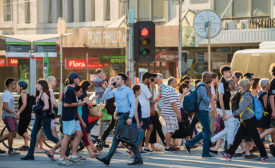Home » Keywords: » pedestrian fatalities
Items Tagged with 'pedestrian fatalities'
ARTICLES
Fed effort to improve bicycle, pedestrian safety gaining momentum
More than 85 cities have signed up for program
February 25, 2015
Get our new eMagazine delivered to your inbox every month.
Stay in the know on the latest safety trends.
SUBSCRIBE TODAYCopyright ©2024. All Rights Reserved BNP Media.
Design, CMS, Hosting & Web Development :: ePublishing



